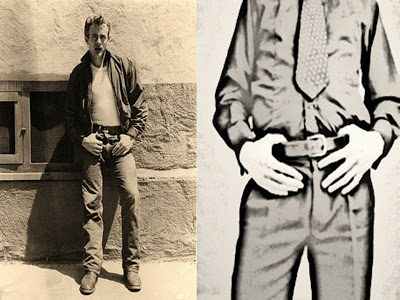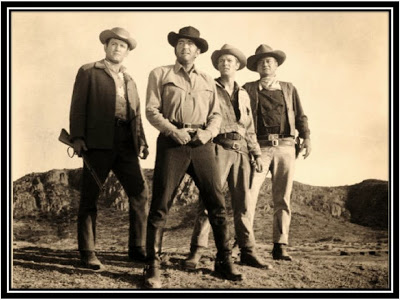When it comes to attraction, males and females use different signals to display their attractive qualities.
Female courtship signals primarily involve displaying beauty and submissiveness. On the other hand, male courtship signals involve a display of wealth, status, and dominance.
One way in which men display dominance is by displaying their crotch. I know it sounds weird but, as I’ll explain later, this behavior is something that we’ve inherited from our ancestors. The most common way in which men display their crotch is by taking up the thumbs-in-belt gesture.
Thumbs in belt or pockets
The thumbs are hooked to the belt or the pockets while the fingers spread out and highlight the crotch. This gesture is used by men to display a dominant, sexually aggressive attitude. It’s perhaps the most direct sexual display a man can make towards a woman.
Men also use this gesture to stake their territory or to show other men that they’re not afraid. This gesture communicates the non-verbal message, “I am virile, powerful and dominant”.

In a seated position, it becomes kind of difficult for men to assume this gesture but they don’t shy away from displaying their crotch if they want to communicate the message of dominance. They’ll spread their legs and lean slightly backward so that their crotch comes forward and in full display.

Watch any group of young men who’re engaged in an activity that requires them to display a macho attitude and you’ll notice that they often stand with their legs apart and their hands somehow highlight their crotch.
For instance, when sports teams are ready for ‘action’ you may notice the players continually adjusting and re-adjusting their crotch as they unconsciously try to assert their masculinity.

Interestingly, this crotch display gesture is also seen in apes and some other primates. Even though the apes don’t wear any belt or trousers, still they highlight their crotch with their hands when they have to stake their territory and show other apes that they’re unafraid.
Some primates such as baboons are a bit more direct. They display dominance by spreading their legs and displaying their penis, giving it continual adjustment or even waving it at their enemies.
What’s even more mind-boggling is that the same penis-waving tactic is also employed by some New Guinea tribes even today who are essentially cut off from modern civilization.
This clearly indicates that such a behaviour is an evolved tendency in homo sapiens.
Dropping the pants
I must have been around 11 or 12 years old. It was a bright Sunday morning and we had arranged a cricket match with some schoolmates. Everything was normal as the game progressed and as usual, both the teams rejoiced at the high points and wore disappointed expressions at the low points of the game.
A rather strange thing happened when the game was over. It was a narrow contest right to the end but our team lost. Needless to say, the other team was elated. They jumped with joy, yelled and screamed. But one particular boy was over-excited. He felt so powerful and dominant due to the win that he dropped his pants and showed his penis to our team.
My team-mates laughed it off but I was taken aback.
I never forgot that incident. I wanted to know why he did that. What possible motive or desire could force a person to resort to such extreme behavior?
It remained an unanswered question, an unresolved problem in my psyche for a long time until years later when I read about human evolution and body language, the whole picture became clear to me.
Another similar and common incident that men experience at least once in their lives is when they jokingly question the size of their friend’s penis, the latter usually gets defensive and retorts with something like, “If I show it to you guys, you’ll become afraid and run away”.
He may not realize it but unconsciously he knows that the penis display is an effective way to display dominance, and so do his friends.
I’m sure you’re intelligent enough to understand, by now, why people display their middle fingers when they want to offend someone and/or to feel dominant.
It’s not an acceptable behavior anymore in a civilized society for adults to drop their pants and show their penises so they use their middle fingers to symbolically convey the same feelings.
Some of you might ask, “Why do women who wear jeans assume the ‘thumbs-in-belt’ gesture?” or “Why do women show their middle fingers, when they have no actual penises to display?”
Well, it’s most probably a behavior that they’ve learned from men. Penis display, symbolical or not, has come to be strongly associated with offending someone or showing dominance in the human psyche, thanks to its effectiveness.
So, women are just using a tool from men’s psychological repertoire because they know how effective it can be.
Subtle forms of crotch display
Belt and crotch-grabbing while dancing is a subtle form of crotch display and men across different cultures do it- from Michael Jackson to Salman Khan. Other subtle forms include wearing tight-fitting pants, small-size speedo swimming trunks or even dangling a large bunch of keys/chains on the front or side of the crotch.
The wallets that have those chains dangling on the side of the crotch became popular among men because it helped them draw attention to their crotch.
To conclude consider what George Carlin, the late American comedian, had to say about wars:
“War is nothing but a whole lot of prick-waving. War is just a lot of men standing around in a field waving their pricks at one another. Of course, the bombs, the rockets, and the bullets are all shaped like dicks. It’s a subconscious need to project the penis into other people’s affairs.”
References
- Pease, B., & Pease, A. (2008). The definitive book of body language: The hidden meaning behind people’s gestures and expressions. Bantam.
- Chandler, J., & Schwarz, N. (2009). How extending your middle finger affects your perception of others: Learned movements influence concept accessibility. Journal of Experimental Social Psychology, 45(1), 123-128.
